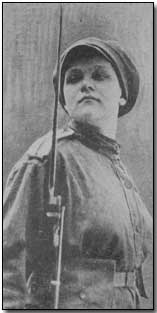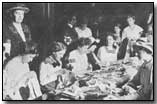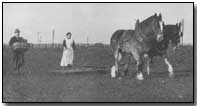Feature Articles - Women and WWI - Women in the Workforce: Temporary Men
 One immediate result of the war's outbreak was the rise in female unemployment,
especially among the servants, whose jobs were lost to the middle-classes' wish
to economise.
One immediate result of the war's outbreak was the rise in female unemployment,
especially among the servants, whose jobs were lost to the middle-classes' wish
to economise.
However, it was soon seen that the only option to replace the volunteers gone to the front was employing women in the jobs they had left behind; conscription only made this need even more urgent as had the Munitions of Work Act 1915 by which munitions factories had fallen under the sole control of the Government.
As the main historian of women's work, Gail Braybon, claims, for many women the war was "a genuinely liberating experience" (link) that made them feel useful as citizens but that also gave them the freedom and the wages only men had enjoyed so far. Approximately 1,600,000 women joined the workforce between 1914 and 1918 in Government departments, public transport, the post office, as clerks in business, as land workers and in factories, especially in the dangerous munitions factories, which were employing 950,000 women by Armistice Day (as compared to 700,000 in Germany).
Women's job mobility also increased enormously, with a large number of women abandoning service for factory work never to return to it to the chagrin of the middle-class women that were left without home help in many cases.
In general, women did very well, surprising men with their ability to undertake heavy work and with their efficiency. By the middle of the war they were already regarded as a force to be proud of, part of the glory of Britain. However, their entrance into the workforce was initially greeted with hostility for the usual sexist reasons and also because male workers worried that women's willingness to work for lower wages would put them out of work.
The Government, besides, combined a welfare policy offering subsidies to families with husbands at the front with increasing female work in order to conscript skilled workers formerly regarded as indispensable to the war effort. To make up for the loss in the skilled workforce the entry of women in factories was often facilitated by 'dilution', that is to say, the breaking down of complex tasks into simpler activities that non-skilled women workers could easily carry out.
 The women employed in munitions factories, popularly known as munitionettes have
became the most visible face of the woman worker in WWI, though doubt
remains as to whether their motivation was patriotic or simply economic. The
factories they manned had been seized by
Lloyd George's Government and he also
caused suspension of all trade union activities in them.
The women employed in munitions factories, popularly known as munitionettes have
became the most visible face of the woman worker in WWI, though doubt
remains as to whether their motivation was patriotic or simply economic. The
factories they manned had been seized by
Lloyd George's Government and he also
caused suspension of all trade union activities in them.
Munitionettes produced 80% of the weapons and shells used by the British Army and daily risked their lives working with poisonous substances without adequate protective clothing or the required safety measures. Although this can be seen as a gauge of their will to sacrifice everything for Britain it should be read, rather, as part of their treatment as cheap, easily replaceable labour.
The public recognition and sympathy that the 'canaries' (thus nicknamed for the yellow tinge that skin exposed to sulphur acquired) received could not make up for their work conditions. Leading trade-unionist Mary MacArthur, Secretary since 1903 of the Women's Trade Union League, led an energetic campaign to demand they were paid as much as the men employed in the same industry - the women only got half the men's wages - but by the end of the war the proportion was roughly still the same.
The Government also invited women to join the ranks of the Women's Land Army, an organisation that offered cheap female labour to farmers not always keen to employ women. The 260,000 volunteers that made up the WLA were given little more than a uniform and orders to work hard as the fuel restrictions made a return to manual agricultural labour unavoidable; unless, that is, the Government used this as an excuse, counting on these women's cheerful acceptance of any hardship to make working the land as cheap as possible.
It's hard to say whether women workers understood from the beginning that their employment could only be temporary but so it was. The same situation was repeated in the main belligerent countries: women were dismissed back home to make room for the returning veterans, only in some cases their efforts were thanked with the right to vote. There are, besides, disagreements among historians, depending on whether they call themselves feminist or not, as to how much resentment this return home generated.
 We must assume single women in families
with no male casualties must have been more resentful than married women whose
families had faced important loses or whose husbands had returned safely from
the front. It's important to remember at any rate, as Joanna Bourke does, that
for women "Even more traumatic [than losing jobs] was the painful process of
readjusting to the return of loved ones from the battlefields. Hundred of
thousands of men returned from the war injured in some way. Women bore a large
part of the burden of caring for these men. Even worse, women lost their
fathers, husbands, lovers, brothers, and sons. For these women, life would never
be the same." Nor would
it be for the men; they, however, needn't fight for their right to have a
job.
We must assume single women in families
with no male casualties must have been more resentful than married women whose
families had faced important loses or whose husbands had returned safely from
the front. It's important to remember at any rate, as Joanna Bourke does, that
for women "Even more traumatic [than losing jobs] was the painful process of
readjusting to the return of loved ones from the battlefields. Hundred of
thousands of men returned from the war injured in some way. Women bore a large
part of the burden of caring for these men. Even worse, women lost their
fathers, husbands, lovers, brothers, and sons. For these women, life would never
be the same." Nor would
it be for the men; they, however, needn't fight for their right to have a
job.
There is, therefore, a generalised consensus among historians that women were not truly emancipated by the Great War in any country involved in it. Ute Daniel explains in The War from Within: German Working-Class Women in the First World War that this was indeed the case for German women, noting that WWI's most important outcome was shifting German factory women workers from one sector to another. She is quite critical that safety standards in factories fell back to 19th century standards and that women only acquired superficial skills as they were expected to be soon demobilised.
In Germany pronatalist policies together with an expanding welfare state focused on the family seem to have overruled the more pragmatic British and French approaches to using women in the war effort. Interestingly, Daniel points out that the German Government did not foresee how the scarcity of consumer goods - especially food - and the pressure this put on women would eventually create pockets of discontent that would undermine the women's support for the war effort.
 In Britain the gains were also modest, clashing not only with the upper and
middle-class women's desire to conquer a firm foothold in the professions but
also with working women's trade unionism. Leaders like Margaret Bonfield saw
with dismay that the 1915 Board of Trade call for women to register at the
Labour Exchange would work against the efforts of trade unions, saturating the
job market with women happy to work for the lowest wages. She and Mary MacArthur
tried to redress the situation asking that all women employed for war service
became trade union members and that they got the same wages as men. They failed
in both accounts.
In Britain the gains were also modest, clashing not only with the upper and
middle-class women's desire to conquer a firm foothold in the professions but
also with working women's trade unionism. Leaders like Margaret Bonfield saw
with dismay that the 1915 Board of Trade call for women to register at the
Labour Exchange would work against the efforts of trade unions, saturating the
job market with women happy to work for the lowest wages. She and Mary MacArthur
tried to redress the situation asking that all women employed for war service
became trade union members and that they got the same wages as men. They failed
in both accounts.
As Gail Braybon and Penny Summerfield observe in Out of the Cage: Women's Experiences in Two World Wars, (1987: 69), only women welders, tutored by the Women's Service Bureau, managed to form during the war a compact, skilled, unionised group though this needn't mean they did stay in their jobs. Joanna Burke adds that while by 1918 around 1,000,000 women were members of female trade unions, their wages did not significantly grow (Women and Employment on the Home Front During World War One, BBC) because of dilution: "By 1931, a working woman's weekly wage had returned to the pre-war situation of being half the male rate in more industries."
Next - The Woman Writer: The Problem of Ventriloquism
Stormtroopers comprised specially trained German assault troops used in 1918.
- Did you know?
